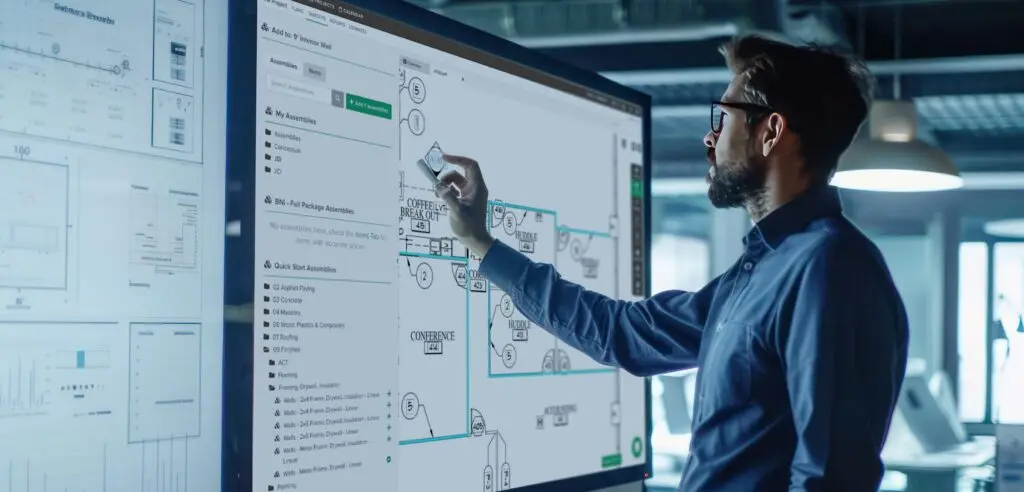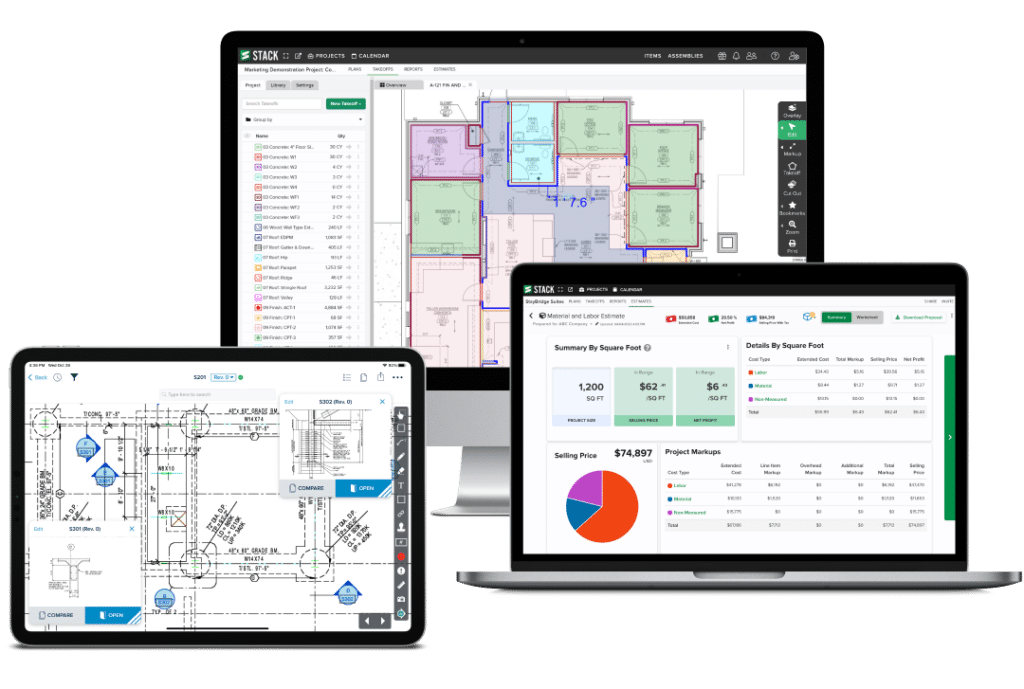
Making the decision to adopt new technology can be challenging. Even the best tools may disrupt your workflow, so how do you know when it’s time to switch from your current platforms? Here are some indicators that it might be time to make a change, along with tips on how to implement new technology efficiently.
Signs Your Current Construction Technology Is Outdated
If you’re considering new tech, you likely suspect that your existing systems are falling behind. These signs can confirm whether it’s time to upgrade.
- Persistent Team Frustration
- Decreased Productivity
- Document Management Issues
- Duplicate Work and Poor Communication
- Departmental Disconnect
The Benefits of New Construction Technology
Adopting new technology can have a broad impact on your business, improving workflow speed, accuracy, and reducing user error. Beyond these expected benefits, you may also see some less obvious advantages.
- Enhanced Data Security: By moving to a cloud-based platform, you reduce the risk of sensitive information being stored on local systems or shared via email. A reputable tech provider will prioritize data security, keeping your information safe.
- Addressing Labor Shortages: Implementing effective technology can help your company scale without needing additional resources. Automating and streamlining processes can boost productivity without overburdening your existing staff.
- Attracting and Retaining Talent: Cutting-edge technology is a significant draw for younger, tech-savvy workers. Millennials and Gen Z expect modern tools in the workplace, and your adoption of top-tier technology can help you attract and retain top talent.
- Improved Forecasting: Newer technology often provides easier access to historical data, allowing for better project reviews and forecasting. With clear insights into budget vs. actuals and other key metrics, you can make more informed decisions about future projects.
Choosing the Right Replacement Technology
When evaluating potential new construction technology software options, it’s crucial to adopt a systematic approach to ensure the chosen solution meets the specific needs of your business. The following steps provide a guide to thinking about this process:
- Define Business Needs and Objectives
Before exploring software options, clearly define your business’s specific needs and objectives. Consider aspects like project management, scheduling, budgeting, collaboration, and reporting. Understanding these requirements will help you identify software that aligns with your goals and addresses pain points in your current processes.
- Research Available Solutions
Conduct thorough research on the software options available in the market. Look for solutions tailored to the construction industry, as they will be more likely to address your unique challenges. Explore reviews, case studies, and testimonials to gather insights into how the software performs in real-world scenarios. Pay attention to the reputation of the vendors and the longevity of their solutions.
- Evaluate Key Features
Focus on the core features offered by the software. Common features in construction technology include project management tools, resource scheduling, document management, cost estimation, and collaboration capability. Ensure the software has the ability to handle the complexity and scale of your projects. Additionally, consider whether the software offers mobile accessibility, as this is increasingly important for onsite work. You can use our free RFP template to track all these features.
- Integration and Compatibility
Evaluate how well the new software integrates with your existing systems. Seamless integration with tools like accounting and CRP software, CRM systems, and other project management tools is crucial to maintaining workflow efficiency. Compatibility with existing hardware and operating systems should also be assessed to avoid costly upgrades or replacements.
- Scalability and Flexibility
Choose a solution that can grow with your business. The construction industry is dynamic, and your software needs to adapt to changing demands. Consider whether the software can handle larger projects, more users, and additional functionalities as your business expands. Flexibility in terms of customization and configurability is also important to tailor the software to your specific workflows.
- Cost Considerations
While cost shouldn’t be the only factor, it’s essential to consider the total cost of ownership. This includes upfront costs, subscription fees, implementation, training, and ongoing support. Ensure that the software provides a good return on investment by improving efficiency, reducing errors, and enhancing project outcomes.
- Support and Training
Evaluate the level of support and training provided by the vendor. A software solution is only as good as its usability, and proper training is essential for successful adoption. Look for vendors that offer comprehensive support, including personalized user training, easy-to-access help documentation, on-demand video tutorials and accessible customer service.
- Trial and Feedback
Before making a final decision, request a trial or demo of the software. Involve key stakeholders in the trial process to gather feedback on its usability, functionality, and overall fit for your business. This hands-on experience will help you make an informed decision and ensure the software meets your expectations. Make sure your whole team is on the same page by leveraging a consistent tool in your evaluation process – try our free RFP template.
Adopting New Tech & Maintaining Team Enthusiasm
Even the best technology can disrupt your workflow if the rollout is slow or poorly managed, and the success of tech adoption largely depends on how well the team embraces the change. Here are some strategies to effectively adopt new technology while keeping your team enthusiastic and engaged.
- Involve the Team Early
Involving the team from the outset is crucial. When choosing new technology, seek input from those who will use it daily – estimators, project managers, foremen. Their insights can guide the selection process, ensuring the technology aligns with the practical needs of the jobsite. Moreover, when employees feel that their opinions are valued, they are more likely to buy into the change.
- Provide Comprehensive Training
Proper training is essential for the successful implementation of any new technology. Organize hands-on training sessions that allow the team to interact with the technology in a controlled environment before it’s fully integrated into the project. Offering continuous learning opportunities and refresher courses can help address any challenges that arise and prevent frustration from building up.
- Highlight the Benefits
People are more likely to embrace change when they see clear benefits. Communicate how the new technology will make their jobs easier, safer, or more efficient. For example, if introducing the use of digital takeoff tools using aerial imagery, emphasize how they can save time and reduce the need for hazardous tasks like climbing on roofs. When the team understands the advantages, they’re more likely to support the transition.
- Lead by Example
Leadership plays a critical role in setting the tone for technology adoption. If management shows enthusiasm and commitment to using the new technology, the team is more likely to mirror that attitude. Demonstrate your willingness to learn and use the technology, and encourage others to follow suit. This not only fosters a culture of learning but also eliminates the “us vs. them” mentality that can sometimes emerge during transitions.
- Encourage Open Communication
Establishing an open line of communication is key to addressing concerns and gathering feedback. Regularly check in with your team to understand their experiences with the new technology. If issues arise, address them promptly and involve the team in finding solutions. This approach not only solves problems more effectively but also empowers the team and builds trust. Make sure your team also shares your feedback with your provider, and that your provider is open to your criticism and takes your ideas into consideration to influence product enhancements.
- Celebrate Successes
Finally, recognize and celebrate milestones achieved with the new technology. Whether it’s a successful project completion or a small efficiency gain, acknowledging these wins reinforces the positive impact of the technology and boosts morale. Public recognition, rewards, or simple team celebrations can go a long way in maintaining enthusiasm.
Bid Faster. Win More. Build Smarter.
Get your FREE account today to:
- Increase Team Efficiency
- Complete Estimates Faster
- Generate More Revenue

With clear criteria and a solid implementation plan, adopting new construction technology is a worthwhile investment that can streamline workflows and enhance efficiency across your projects.
If you’re ready to upgrade, ask STACK about our implementation services and training options for your team today.






